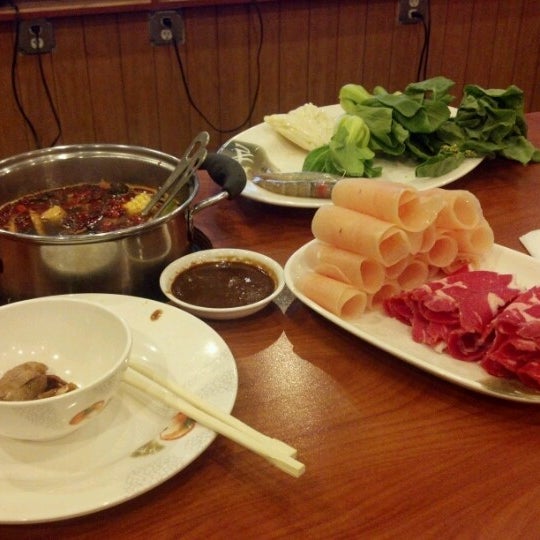
Regional variations East Asia China A Sichuan-style double hot pot with sour suan cai and spicy mala broths Instant-boiled mutton in BeijingĬhinese hot pots are often divided into "Southern style" and "Northern style", paralleling the cultural regions of China. Varieties of mushrooms, such as straw mushrooms, enoki (金针菇), Shiitake (香菇), and oyster mushrooms.Tofu, tofu skin, Fu zhu, Japanese style fish tofu, frozen tofu or fried tofu.
 Thinly sliced lamb, goat, beef, sometimes pork, chicken or other poultry. Meats and protein vary, and can include:. Since the 1990s, as the number of Chinese immigrants entering the United States has grown significantly, Chinese food has also spread to the United States, and hot pot has also moved to the forefront of the global culinary scene. Empress Dowager Cixi was also known to have enjoyed hot pot, especially in the winter months. Later, the Jiaqing Emperor also had a banquet with 1,550 hot pots at his coronation. In particular, the Qianlong Emperor was very fond of hot pot and would eat it for almost every meal. Later, a hot pot made with copper was created during the "Three Kingdoms period" (200–280 AD), which is generally acknowledged as the origin of the hot pot.ĭuring the Qing dynasty, hot pot became popular among the emperors. The main part of ran lu was a small stove with a small pot above burning charcoal. Diners among the nobility each had a personal pot made of bronze, and called ran lu ( 燃炉/燃爐). The tripods of Zhou dynasty may be the earliest prototypes of the hot pot. Most raw foods can be cooked in a hot pot, although they may have different cooking times, and must be immersed in the soup and then removed accordingly.Īt the conclusion of the meal, the broth would have acquired many flavors from the added ingredients and may be served to the diners after turning off the heat source. Raw ingredients are pre-sliced into thin sections that will cook quickly and consistently in the simmering broth, which is kept at a gentle boiling temperature.
Thinly sliced lamb, goat, beef, sometimes pork, chicken or other poultry. Meats and protein vary, and can include:. Since the 1990s, as the number of Chinese immigrants entering the United States has grown significantly, Chinese food has also spread to the United States, and hot pot has also moved to the forefront of the global culinary scene. Empress Dowager Cixi was also known to have enjoyed hot pot, especially in the winter months. Later, the Jiaqing Emperor also had a banquet with 1,550 hot pots at his coronation. In particular, the Qianlong Emperor was very fond of hot pot and would eat it for almost every meal. Later, a hot pot made with copper was created during the "Three Kingdoms period" (200–280 AD), which is generally acknowledged as the origin of the hot pot.ĭuring the Qing dynasty, hot pot became popular among the emperors. The main part of ran lu was a small stove with a small pot above burning charcoal. Diners among the nobility each had a personal pot made of bronze, and called ran lu ( 燃炉/燃爐). The tripods of Zhou dynasty may be the earliest prototypes of the hot pot. Most raw foods can be cooked in a hot pot, although they may have different cooking times, and must be immersed in the soup and then removed accordingly.Īt the conclusion of the meal, the broth would have acquired many flavors from the added ingredients and may be served to the diners after turning off the heat source. Raw ingredients are pre-sliced into thin sections that will cook quickly and consistently in the simmering broth, which is kept at a gentle boiling temperature. 
Typical hot pot ingredients include thinly sliced meat, leaf vegetables, mushrooms, vermicelli, sliced potatoes, bean products, egg dumplings, tofu, and seafood. Hot pots can be prepared and eaten at home or in a restaurant.
:no_upscale()/cdn.vox-cdn.com/uploads/chorus_image/image/62165789/37274221_2012677422078274_6309180612771053568_o.0.jpg)
Hot pot is considered a main course and is usually served without rice or noodles on the side. The cooked pieces are dipped into dipping sauces for additional flavor. Raw ingredients, such as meat and vegetables, are placed into the simmering broth and thus cooked. The broth is brought to a boil and left simmering for the duration of the meal. Hot pot is a flavorful broth traditionally served inside a large metal pot. Description Hot pot with two flavors Hot pot from Yunnan, China 'fire pot'), also known as soup-food or steamboat, is a dish whereby a heat source placed on the dining table keeps a pot of soup stock simmering, and a variety of Chinese foodstuffs and ingredients are served beside the pot for the diners to put into the hot stock. Hot pot or hotpot ( simplified Chinese: 火锅 traditional Chinese: 火鍋 pinyin: huǒguō lit.




:no_upscale()/cdn.vox-cdn.com/uploads/chorus_image/image/62165789/37274221_2012677422078274_6309180612771053568_o.0.jpg)


 0 kommentar(er)
0 kommentar(er)
